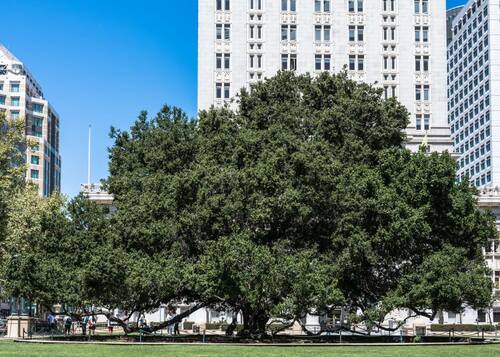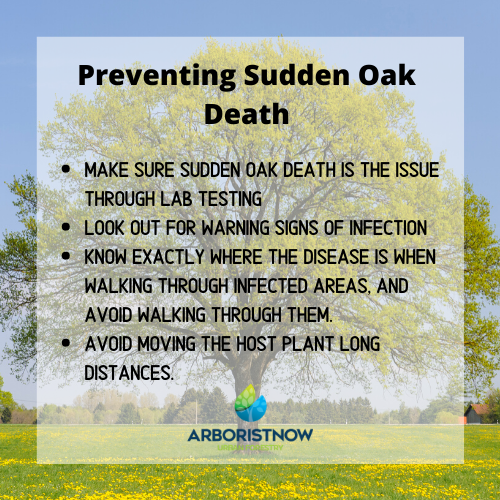A Comprehensive Guide to Sudden Oak Death: Prevention, Symptoms, and Treatment
Understanding Sudden Oak Death: A Threat to California’s Forests
Sudden Oak Death (SOD) is a devastating tree disease that has become a significant concern for homeowners, landscapers, and tree care specialists in California. This comprehensive guide will explore the causes, symptoms, prevention methods, and treatment options for Sudden Oak Death, providing valuable information for those looking to protect their trees and landscapes.
What is Sudden Oak Death?

A Large Oak Tree in a City Park
Sudden Oak Death is caused by Phytophthora ramorum , a plant pathogen that primarily affects oak species such as tan oak, live oak, and black oak. Unlike many tree diseases, P. ramorum is not airborne but instead spreads through soil and water. This pathogen also causes Phytophthora canker diseases , ramorum leaf blight , and ramorum dieback. This forest disease has claimed numerous trees along the central California coast and into southern Oregon, making it a severe threat to the region’s ecosystem.
Key Points about Sudden Oak Death:
- Caused by the pathogen Phytophthora ramorum
- Primarily affects oak species but can infect other trees and shrubs
- Spreads through soil and water, not air
- Has killed many trees in California and Oregon
How Sudden Oak Death Affects Trees
Sudden Oak Death impacts trees in various ways, depending on the species affected:
- Trunk Infection: Most oak species are infected through the trunk, developing bleeding cankers that ooze red or black liquid.
- Leaf Infection: Tan oaks can be infected through their leaves, showing distinct leaf spots.
- Canopy Dieback: Infected trees may become susceptible to bark beetle attacks and fungal growth.
It’s important to note that California bay laurel trees may be infected before nearby oak trees, often showing subtle symptoms that can go unnoticed until it’s too late.
Where is Sudden Oak Death Most Active?
Sudden Oak Death thrives in specific environmental conditions:
- Moist, cool, and foggy areas
- Central and northern coast of California
- Southwest Oregon
- Forests with a mix of host plants and associated host plants
- Areas with California bay laurel trees nearby
The disease has also been found in nursery systems in Oregon, California, Washington, Europe, and British Columbia, highlighting the importance of proper plant quarantine and transportation practices.
Preventing and Managing Sudden Oak Death

Preventing Sudden Oak Death: Learn How to Protect Oak Trees from This Devastating Disease
Early Detection and Prevention Strategies
Preventing Sudden Oak Death requires vigilance and proactive measures:
- Regular Tree Inspection: Monitor your trees for early signs of infection.
- Laboratory Testing: If you suspect infection, have samples tested by your county agriculture department or UC Cooperative Extension office .
- Stay Informed: Keep up-to-date on SOD outbreaks in your area.
- Avoid Moving Infected Plant Material: This helps prevent the spread of the disease.
- Practice Proper Sanitation: Clean tools and equipment when moving between potentially infected areas.
Warning Signs to Watch For
Be on the lookout for these indicators of potential Sudden Oak Death infection:
- Large sections of dead live oaks or tan oaks within 1-3 miles of your property
- Subtle signs of infection on nearby bay laurel trees
- Suspicious symptoms on your own trees, such as trunk cankers or leaf spots
Treatment Options for Sudden Oak Death
While there is no cure for Sudden Oak Death, some treatment options can help manage the disease:
1. Phosphonate Fungicide (Agri-Fos) : The most successful chemical treatment for SOD.
- Effective for tan oaks and true oak species
- Works as a preventative measure and can slow disease progression in recently infected trees
- Can be applied through direct injection or topical bark application
2. Tree Removal: In severe cases, removing infected trees may be necessary to prevent further spread.
Professional Help for Sudden Oak Death Management
Given the complexity of Sudden Oak Death management, it’s often best to consult with professional arborists or tree care specialists. They can provide:
- Accurate diagnosis of Sudden Oak Death
- Proper application of treatments
- Guidance on prevention strategies
- Expert tree removal services if necessary
Conclusion: Protecting California’s Oaks from Sudden Oak Death

An Oak Tree Overlooking a Flower-covered Hillside
Sudden Oak Death poses a significant threat to California’s iconic oak trees and forest ecosystems. By understanding the disease, recognizing its symptoms, and taking proactive measures, we can work together to minimize its impact. Stay vigilant, practice good forest management techniques, and don’t hesitate to seek professional help when needed. Together, we can protect our valuable oak trees and preserve California’s natural beauty for generations to come.
If you are located in the San Francisco Bay Area, Arborist Now would be happy to help you with any questions and preventative treatment or removal you may need. Contact us today for further assistance!
Originally posted on January 30, 2020.


